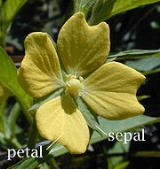
Petal
Encyclopedia
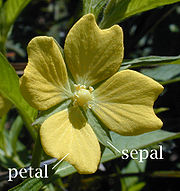
Flower
A flower, sometimes known as a bloom or blossom, is the reproductive structure found in flowering plants . The biological function of a flower is to effect reproduction, usually by providing a mechanism for the union of sperm with eggs...
s. They often are brightly colored or unusually shaped to attract pollinator
Pollinator
A pollinator is the biotic agent that moves pollen from the male anthers of a flower to the female stigma of a flower to accomplish fertilization or syngamy of the female gamete in the ovule of the flower by the male gamete from the pollen grain...
s. Together, all of the petals of a flower are called a corolla. Petals are usually accompanied by another set of special leaves called sepal
Sepal
A sepal is a part of the flower of angiosperms . Collectively the sepals form the calyx, which is the outermost whorl of parts that form a flower. Usually green, sepals have the typical function of protecting the petals when the flower is in bud...
s lying just beneath the corolla. When the petals and sepals of a flower look similar they are called tepal
Tepal
Tepals are elements of the perianth, or outer part of a flower, which include the petals or sepals. The term tepal is more often applied specifically when all segments of the perianth are of similar shape and color, or undifferentiated, which is called perigone...
s. Examples of plants in which the term tepal is appropriate include genera
Genus
In biology, a genus is a low-level taxonomic rank used in the biological classification of living and fossil organisms, which is an example of definition by genus and differentia...
such as Aloe
Aloe
Aloe , also Aloë, is a genus containing about 500 species of flowering succulent plants. The most common and well known of these is Aloe vera, or "true aloe"....
and Tulipa. Conversely, genera such as Rosa
Rose
A rose is a woody perennial of the genus Rosa, within the family Rosaceae. There are over 100 species. They form a group of erect shrubs, and climbing or trailing plants, with stems that are often armed with sharp prickles. Flowers are large and showy, in colours ranging from white through yellows...
and Phaseolus
Phaseolus
Phaseolus is a genus in the family Fabaceae of about fifty plant species, all native to the Americas.At least four of the species have been domesticated since pre-Columbian times for their beans. Most prominent among these is the common bean, P...
have well-distinguished sepals and petals.
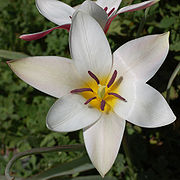
Variations
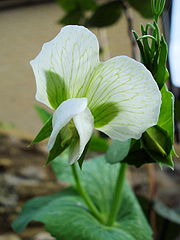
Merosity
Merosity is the number of component parts in each whorl of a plant structure. It is most commonly used in the context of flowers, in which case it refers to the number of sepals in the calyx, the number of petals in the corolla, and the number of stamens in each whorl of the androecium...
may hold clues to a plant's classification. For example, flowers on eudicots
Eudicots
Eudicots and Eudicotyledons are botanical terms introduced by Doyle & Hotton to refer to a monophyletic group of flowering plants that had been called tricolpates or non-Magnoliid dicots by previous authors...
(the largest group of dicots
Dicotyledon
The dicotyledons, also known as dicots, are a group of flowering plants whose seed typically has two embryonic leaves or cotyledons. There are around 199,350 species within this group...
) most frequently have four or five petals while flowers on monocots
Monocotyledon
Monocotyledons, also known as monocots, are one of two major groups of flowering plants that are traditionally recognized, the other being dicotyledons, or dicots. Monocot seedlings typically have one cotyledon , in contrast to the two cotyledons typical of dicots...
have three or six petals, although there are many exceptions to this rule.
The petal whorl or corolla may be either radially or bilaterally symmetrical (see Symmetry in biology and Floral symmetry). If all of the petals are essentially identical in size and shape, the flower is said to be regular or actinomorphic (meaning "ray-formed"). Many flowers are symmetrical in only one plane (i.e., symmetry is bilateral) and are termed irregular or zygomorphic (meaning "yoke-" or "pair-formed"). In irregular flowers, other floral parts may be modified from the regular form, but the petals show the greatest deviation from radial symmetry. Examples of zygomorphic flowers may be seen in orchids and members of the pea family
Fabaceae
The Fabaceae or Leguminosae, commonly known as the legume, pea, or bean family, is a large and economically important family of flowering plants. The group is the third largest land plant family, behind only the Orchidaceae and Asteraceae, with 730 genera and over 19,400 species...
.
In many plants of the aster family
Asteraceae
The Asteraceae or Compositae , is an exceedingly large and widespread family of vascular plants. The group has more than 22,750 currently accepted species, spread across 1620 genera and 12 subfamilies...
such as the sunflower, Helianthus annuus, the circumference of the flower head
Head (botany)
The capitulum is considered the most derived form of inflorescence. Flower heads found outside Asteraceae show lesser degrees of specialization....
is composed of ray florets. Each ray floret is anatomically an individual flower with a single large petal.
Although petals are usually the most conspicuous parts of a flower, some species, such as grasses
Poaceae
The Poaceae is a large and nearly ubiquitous family of flowering plants. Members of this family are commonly called grasses, although the term "grass" is also applied to plants that are not in the Poaceae lineage, including the rushes and sedges...
, have either very small petals or lack them entirely.
Similar structures
Sometimes botanically different parts have the appearance of petals. In the genus CannaCanna (plant)
Canna is a genus of nineteen species of flowering plants. The closest living relations to cannas are the other plant families of the order Zingiberales, that is the gingers, bananas, marantas, heliconias, strelitzias, etc.Canna is the only genus in the family Cannaceae...
the true petals are tiny while the stamen
Stamen
The stamen is the pollen producing reproductive organ of a flower...
s are large and brightly colored. A number of plants have bract
Bract
In botany, a bract is a modified or specialized leaf, especially one associated with a reproductive structure such as a flower, inflorescence axis, or cone scale. Bracts are often different from foliage leaves. They may be smaller, larger, or of a different color, shape, or texture...
s that resemble petals, for example in Bougainvillea
Bougainvillea
Bougainvillea is a genus of flowering plants native to South America from Brazil west to Peru and south to southern Argentina . Different authors accept between four and 18 species in the genus...
, Cornus florida (flowering dogwood) and members of the Euphorbiaceae
Euphorbiaceae
Euphorbiaceae, the Spurge family are a large family of flowering plants with 300 genera and around 7,500 species. Most are herbs, but some, especially in the tropics, are also shrubs or trees. Some are succulent and resemble cacti....
family.
Corolla
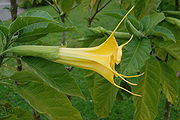
Perianth
The term perianth has two similar but separate meanings in botany:* In flowering plants, the perianth are the outer, sterile whorls of a flower...
. The role of the corolla in plant evolution
Evolution
Evolution is any change across successive generations in the heritable characteristics of biological populations. Evolutionary processes give rise to diversity at every level of biological organisation, including species, individual organisms and molecules such as DNA and proteins.Life on Earth...
has been studied extensively since Charles Darwin
Charles Darwin
Charles Robert Darwin FRS was an English naturalist. He established that all species of life have descended over time from common ancestry, and proposed the scientific theory that this branching pattern of evolution resulted from a process that he called natural selection.He published his theory...
postulated a theory of the origin of elongated corollae.
If the petals are free from one another in the corolla, the plant is polypetalous or choripetalous; while if the petals are at least partially fused together, it is gamopetalous or sympetalous.
Genetics
The genetics behind the formation of petals, in accordance with the ABC model of flower development, are that sepals, petals, stamenStamen
The stamen is the pollen producing reproductive organ of a flower...
s, and carpels are modified versions of each other. It appears that the mechanisms to form petals evolved very few times (perhaps only once), rather than evolving repeatedly from stamens.

